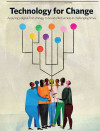 (Illustration by Mark McGinnis)
(Illustration by Mark McGinnis)

When Sarah Angel-Johnson came to the Girl Scouts as its first-ever chief digital cookie executive, she took over an $860 million business tied to a century-old institution. Her mission: help modernize the organization and grow its cookie sales into a billion-dollar enterprise.
Technology for Change

Nonprofits need digital technology to meet today’s pressing challenges and serve their communities. This collection of articles explores the ways in which the social sector can and already is applying a digital-first strategy to boost its effectiveness. Sponsored by Salesforce
-
Grecian Urns and Trend Reports
-
Invading the Darkness of Child Sex Trafficking
-
From Measurement to Success
-
Technology Is Her Compass and Data Is Her Guide
-
Tech and Data That Inform, Inspire, and Involve
-
Data-Driven Connections for a Better World
-
Being a Digital-First Leader
-
Creating a Digital-First Strategy
-
Driving Social Change With Data
Keeping with the Girl Scouts’ goals of teaching self-reliance and service, Angel-Johnson saw an added opportunity to infuse some modern business sense into the nonprofit and transform it from a pen-and-paper operation into a digital-first operation.
“We are doing our girls a disservice by not teaching them leading-edge business skills,” she says. “We should be teaching girls about e-commerce, supply chains, and data analytics, and you can’t teach that if you’re just walking around with [order slips].”
Angel-Johnson spent more than 16 years at IBM; she knew the for-profit world inside and out. So when she landed at the Girl Scouts in 2014, she faced an adjustment. “Where is my team?” she says she wondered.
But then she got to work. “As a technologist coming from IBM and having a large team, and then moving into a Wild West where anything goes and knowing what you do [will affect] 1.8 million girls’ lives, I just knew I had to get it right,” she says. And Salesforce was at the heart of that transformation. The first iteration of the project wasn’t perfect, she admits, but from there, “digital cookie became better, better, better, every iteration after that.”
Angel-Johnson’s experience mirrors that of many other nonprofit employees. For the second year in a row, Salesforce surveyed hundreds of nonprofits from around the world to assess what issues, trends, and opportunities they were experiencing in the sector. The resulting Nonprofit Trends Report concluded that 75 percent of nonprofits reported an increase in demand for their programs, and a whopping 85 percent agreed that technology is the key to future success.
Despite these stats, program teams lag behind other departments when it comes to adopting new technologies, the report says. Although the vast majority of nonprofits say that technology can replace a lot of time-intensive manual tasks, about one-quarter say they still reply on paper for most activities.
So, why is it that large and complex nonprofits like the Girl Scouts have only recently decided to take their wares online? For one, it’s hard to make systemic change if you don’t have the proper resources for it. Many nonprofits are underfunded and lack proper IT support. The Nonprofit Trends Report finds that many nonprofits have a hard time funding the types of technology they need to grow their programs, with 51 percent of nonprofits reporting budget constraints and 40 percent not being able to prove return on investment.
Aparna Kothary, director of technology at Global Citizen Year, which helps young adults with “gap year” study-abroad programs between high school and college, says it is critical to convey the value of technology to leadership prior to implementation, because the tech does “come at a cost.” Since most nonprofits have limited resources, she says, your first hire “is not going to be a technology person, for the most part—you are going to focus on your program and on fundraising.” Thus, when you get to the point of expanding your tech, you need to persuade leaders that it is a good investment of organizational funds.
“Figuring out how to show the impact of a technology implementation [to leadership] is key,” Kothary says. She recommends trying to answer these questions: “What’s the return on the project? How much time will it save staff members? How much frustration will it save people? What information will it give us that we didn’t have before? What information and what abilities will it give us that we didn’t have before?”
With 52 full-time employees, Global Citizen Year is a relatively small organization, but large, established nonprofits often develop deep, disconnected data silos over many years of operation. The Girl Scouts, for instance, is made up of 113 separate 501c3s—so trying to implement a digital strategy there was no small feat, says Angel-Johnson.
“Nonprofits tend to recreate the wheel every time [they launch a project], instead of trying to come up with a framework and infrastructure to address different needs,” says Robert Goerge, a senior research fellow in public policy at Chapin Hall at the University of Chicago. “They have all these one-offs, but there’s no long-term planning around building databases or even storing data in a way they can use it for the future.” Goerge says this is more common for small nonprofits with fewer departments, but that a persistent problem is developing a “common structure [that can] address all needs.” This echoes another finding from the survey: Organizations that have “fully aligned” strategies that are informed by robust data are the most likely to succeed.
What does it mean to have a fully aligned strategy? For Angel-Johnson, it meant getting the Girl Scouts’ 113 separate nonprofits to work together as a unified entity. And Salesforce, she says, was at the heart of that transformation, because the first step was to pull all of their data and their customer insights together, which the Salesforce platform enabled her to do. “If you can’t understand the insights of your business and your customers, it is very difficult to move forward in a transformational way,” she says. But if you can channel the power of 1.8 million girls, she adds, “you can change the world.”
The Great Megaphone
How can nonprofits adopt a digital-first strategy? For starters, it’s about the strategy, not the technology, says Alva H. Taylor, faculty director of the Glassmeyer/McNamee Center for Digital Strategies at the Tuck School of Business at Dartmouth College. “You first have to start with a great understanding of what you’re trying to do, what your goals are,” he says. “And then digital is the tool that expresses and executes your strategy.”
Adopting this perspective can be a problem for nonprofits, Taylor says, because the way they measure success—success by which they plan future programming—can vary widely. For example, if you are measuring the impact of a program on the health of a particular population, you won’t know if you’ve done it right until a few years down the road. “So, it’s important in that environment, for both funding and execution, that you’re clear that everything you do focuses on your promise to your constituents,” he says. “And digital should support that.”
Angel-Johnson agrees with this sentiment. “I don’t want to talk tech first,” she says. “It’s about the human that you’re trying to impact from a social perspective.” Human-centered design thinking needs to drive the iterative process of finding solutions to problems, she says, to benefit the human experiencing the digital innovation. And in order to connect with that human, Taylor adds, you need “a clarity of voice, mission, and brand”—which is what digital truly excels at, he says. He calls digital a “great megaphone,” which is excellent at broadcasting a message, but if your strategy is not clear at the outset, “then you are just yelling as opposed to communicating.”
The flip side of clear and consistent communication means that consumers now expect this standard from both profits and nonprofits alike. “You can’t be giving people a quarterly project update on something they’ve got,” Taylor says. “You’ve got to have a system set up so they know where you are in the project.” If someone can order lunch via Postmates and know where their food is every step of the process, then they will expect to know how, where, and when their money is being used to further a cause. That’s the level of specificity people now expect, and if you can do this via the technology you implement, “the easier it is for these companies to work with you, the easier is for constituents to work with you, and the easier it is for people to fund you,” Taylor says. “If you want to grow, that’s not an option.”
The majority of nonprofits see scaling as essential. And, accordingly, says the Nonprofit Trends Report, 41 percent of them are scaling their technology and infrastructure to meet the growing needs of their constituents. They have no choice: Modern nonprofits face a new landscape with many pitfalls and challenges, the fate of the world seemingly in the balance.
“I think that nonprofits are changing even faster than for-profits,” says Angel-Johnson. “And so that means nonprofits are going to have to change the way that they scale and grow to have deeper social impact than ever before.”
Support SSIR’s coverage of cross-sector solutions to global challenges.
Help us further the reach of innovative ideas. Donate today.
Read more stories by Adrienne Day.

